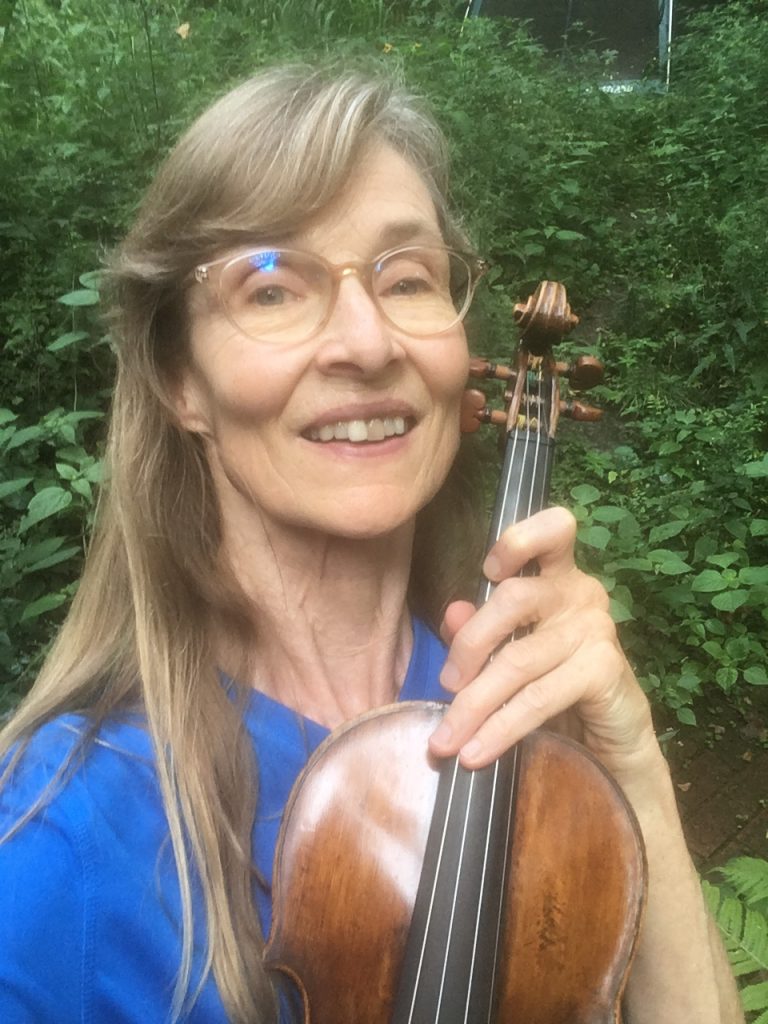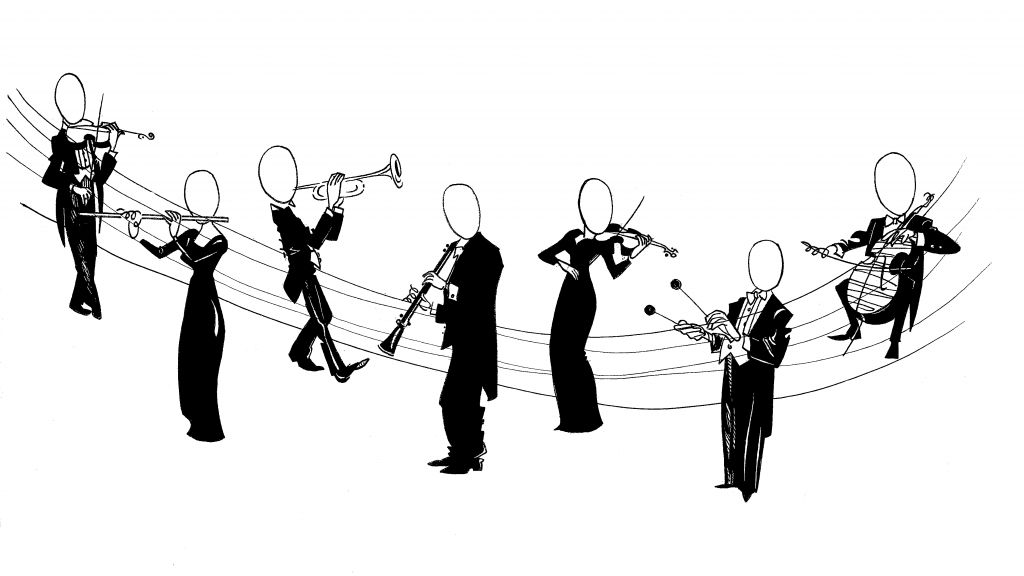Spotlight on Lisa Scott

Lisa Scott moved to Bloomington, Indiana when she was just a few months old, started studying music there at age five, and ultimately attended her hometown Indiana University, where she received a Bachelor’s degree in violin performance. Lisa joined the ISO in 1983, while in the process of finishing her degree at IU.
Lisa is also a talented artist, having drawn many illustrations for our website, including our new logo, as well as the images for the new Teddy Bear series The Runaway Strings.
We sat down with with Lisa in late August 2020:
Thanks for taking the time to talk with us, Lisa! How did you decide to play violin in the first place?
I started playing piano at age five and picked up violin at age seven. I don’t think I picked violin specifically but picked something that would fit in a Beethoven symphony or string quartet.
At home, we listened often to recordings of Beethoven symphonies, which were my favorite. My father even created a little suspense by making me wait until I was nine to hear his ninth (possibly only a few months by the time I knew it existed — I don’t remember exactly). Eventually, I finally listened with great pleasure, until suddenly the (unwelcome, to me) singing started.
My favorite instrument is actually the cello, but I don’t remember ever asking for cello lessons, although I’m sure I could have had them. It took me a while to learn to love the sound of the solo violin. I originally preferred the very different sonority of a section of violins.
It sounds like you developed your musical affinity early!
My love for music began at such a young age, as my father, a physics professor at IU, also played cello in an amateur string quartet that read music weekly at our home. My parents also played piano, and my two younger brothers both joined me in taking music lessons. I was a classical music snob, but my brothers were not, so I fortunately heard a variety of popular music at home.
Playing in youth orchestra at IU and the Bloomington Symphony community orchestra when I was in middle and high school furthered my love of the symphonic and chamber orchestra repertoire, and living in Bloomington afforded me the opportunity to regularly attend great concerts at the IU School of Music.
When I was 12, my teacher, Jacques Israelievitch, required me to attend the Opera at IU, to which my parents already held tickets. It was a stretch for me, but I now appreciate his belief that children needed to be immersed in art.
What kind of violin do you play?
My instrument is an “unknown” violin, by which I mean it has no official pedigree. It is described on the bill of sale as being an old Italian or German instrument.
The process of buying a violin is stressful, since it’s a big purchase and there are so many qualities a player wants: sound under the ear and in the hall, responsiveness, compatibility with whatever bow a player is using, and the impossible-to-define voice of a particular violin.
I was lucky that my father found my current violin through a friend, after I’d played several years in the ISO. He brought it to me, and from the very first note, I loved it.
What is your favorite memory from playing in the ISO all these years?
The most profoundly affecting moments in music are, by nature, fleeting. I have been struck countless times at how lucky I am to be playing onstage in the ISO, surrounded by great colleagues, when those moments happen, witnessed by our audiences, whom we miss so much now.
While these ineffable moments pass too quickly, experiencing them together with people who choose to gather for the purpose makes them more real and lasting. The symphony orchestra is a gigantic, living, breathing musical instrument, whose complexity and expressive power is truly astonishing.
Even at this late stage in my career, I still find the sounds that it produces to be amazing; simply hearing the orchestra tuning up before a concert or rehearsal – the great palette of swirling sound preparing to coalesce into the miracle of music – is a kind of thrill.
Unfortunately, the same expressive range and complexity that allow the orchestra to evoke sublime feelings can also make for some rare but memorable mistakes, such as occurred once long ago when at the downbeat the orchestra began playing in two different, wildly contrasting sections of Aaron Copeland’s Buckaroo Holiday. The result, while embarrassing to everyone and distinctly unfunny to the conductor, was impossible to hear without being seized by extremely inappropriate and unprofessional laughter. The sight of one of our percussionists ducking for cover behind the bass drum is hard to forget.
Your husband and his brother are also longtime orchestra members. What is it like to play so closely with so many family members?
I have had the immeasurable good luck to have shared my entire adult musical life with my husband Perry Scott, ISO Associate Principal cellist, whom I met in Bloomington when I was in high school and he was a music student at IU, in my father’s Acoustical Physics class. Perry and I raised our two sons, Aaron Scott and Brian Scott, in Indianapolis.
Together we have shared a long career with the ISO, and with the Scott Chamber Players piano quartet, which we formed with Perry’s brother, retired ISO violist Beverly Scott, and his wife, pianist Sylvia Patterson-Scott, who has played regularly as ISO keyboardist during the span of my career. We are so grateful that the stars aligned and we started playing in a piano quartet with those two; we all just clicked.
Still, Being married to a person who shares your career can also cut both ways. But in my case, without Perry, I would surely have stumbled far more than I have. We talk about music and playing every day, and I probably go to him TOO often, when I get stuck on a violin problem. We play for each other and offer criticism, but a person has to be ready to hear critical comments or it can be quite annoying, especially when it really hits home!
Do you have any advice for young musicians who are weighing their options in the current climate?
I came to the ISO from the IU School of Music, having played a few times as an ISO substitute during my Senior year there. I had played two summers with the New Hampshire Music Festival Orchestra before I started at ISO.
Like many if not most musicians, I played numerous auditions, over a period of years, before winning a position. Still today I sometimes cannot believe that I was finally lucky enough to do so. Having served on many audition committees here at ISO, I have had the painful experience of watching scores of top flight violinists trudge out of the Hilbert Circle Theater to resume their audition circuit.
The young music school graduates coming up today are first rate, and the ones we have recently added to our roster are, to a person, fantastic players technically and musically, as well as exemplary human beings. During the current pandemic-induced-shutdown, I hope every day that these young musicians, so deserving of the best career music can offer, will soon be back onstage and out in our Indianapolis community, bringing great music of all kinds to a wider and wider audience. Here is to their future, and ours.

Thanks, Lisa! We all love you for your musicianship and other diverse talents, and we look forward to a time where we can share your music with us again!